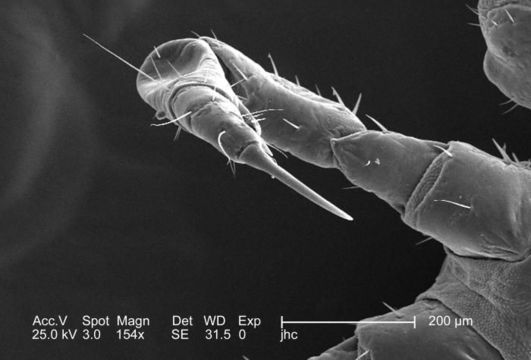Image of human body louse

Description:
At half the magnification of PHIL# 9241, this 2006 scanning electron micrograph (SEM) depicted a dorsal view of the right flexed foreleg of a female body louse, Pediculus humanus var. corporis, in its entirty. What is visible includes the most distal segment, known as the pretarsus, followed by the more proximal tarsus, then the tibia, femur, and trochanter, and finally the most proximal segment, the coxa. In the case of the louse, the leg segments are very stout, and end in claws, which it used to firmly grasp clothing, or a hosts hair shafts. Note how the exoskeletal covering appears to possess an almost fabric-like appearance to the chitinous exoskeleton, which acts to add flexibility at the coxa-trochanteric joint.
Created: 2006
Included On The Following Pages:
- Life (creatures)
- Cellular (cellular organisms)
- Eukaryota (eukaryotes)
- Opisthokonta (opisthokonts)
- Metazoa (Animal)
- Bilateria
- Protostomia (protostomes)
- Ecdysozoa (ecdysozoans)
- Arthropoda (arthropods)
- Pancrustacea
- Hexapoda (hexapods)
- Insecta (insects)
- Pterygota (winged insects)
- Neoptera (neopteran)
- Paraneoptera
- Psocodea (bark lice, book lice and true lice)
- Troctomorpha (book louse)
- Pediculidae (primate body lice)
- Pediculus
- Pediculus humanus (human body louse)
- Panarthropoda
- Nanopsocetae
This image is not featured in any collections.
Source Information
- license
- cc-publicdomain
- photographer
- Janice Carr
- provider
- Public Health Image Library
- original
- original media file
- visit source
- partner site
- Public Health Image Library
- ID


